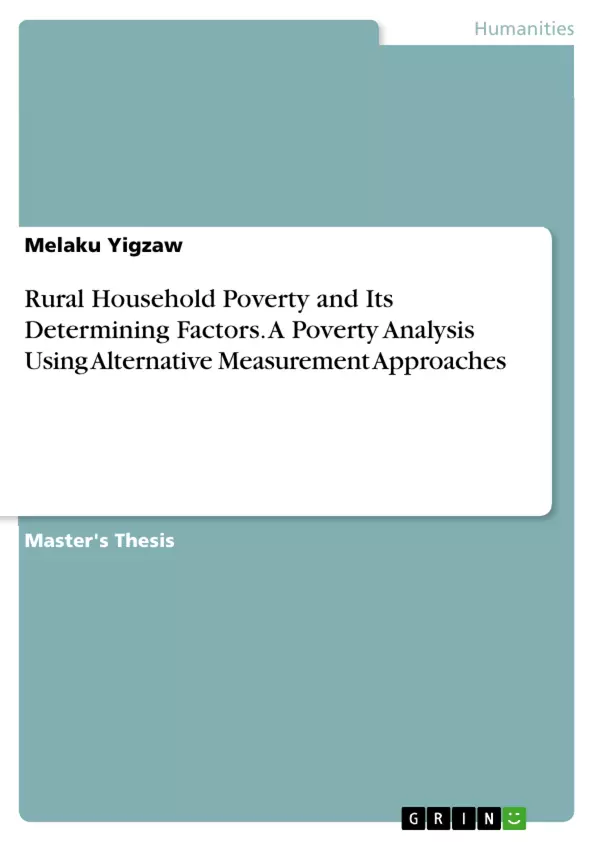In developing countries like Ethiopia, our day-to-day formal and informal discourses are rarely out of poverty issues that can be linked directly or indirectly. Despite the determined effort of government and development agencies to reduce poverty and ensure sustainable development, poverty remains an everlasting challenge of the world. This study aims to examine rural household poverty and its determining factors using alternative poverty measurement approaches, in case of Gozamin Woreda, East Gojjam Zone of Amhara Region.
It used both objective and subjective based poverty analysis approaches, where the survey based analysis and PPA of the study depend on randomly selected 242 and 42 sample households respectively. Using cost of basic needs approach (CBN), the poverty line of the study area is estimated as 19.16 Birr per day per adult equivalent. The study engaged Foster, Greer and Thorbecke (FGT) group of poverty measures to assess the incidence, depth and intensity of poverty and decompositions were made across sample Kebeles and socio-economic variables. OLS, logit and censored (Tobit) regression models were also applied to identify determining factors of household consumption expenditure, poverty incidence, depth and severity.
PPA findings revealed that, perception of the community towards poverty is beyond the conventional, income/consumption based definition. Therefore, development policies and poverty reduction strategies should respond to rapid rural population growth. Moreover, Dega agro-ecological areas need particular attention all the way through poverty reduction efforts.
Inhaltsverzeichnis (Table of Contents)
- ACKNOWLEDGMENTS
- TABLE OF CONTENTS
- LIST OF TABLES
- LIST OF ACRONYMS
- ABSTRACT
- CHAPTER ONE
- INTRODUCTION
- 1.1. Background
- 1.2. Problem Statement
- 1.2.1. Research Questions
- 1.3. Objectives
- 1.3.1. General Objective
- 1.3.2. Specific objectives
- 1.4. Significance of the Study
- 1.5. Scope of the Study
- 1.6. Description of the Study Area
- 1.7. Limitation of the Study
- CHAPTER TWO
- LITRATURE REVIEW
- 2.1. Introduction
- 2.2. Theoretical Literature Review
- 2.2.1 Understanding the concept and definition of poverty
- 2.2.2. Economic theories of poverty
- 2.2.3. Measuring Poverty
- 2.2.3.1. Concepts of measuring poverty
- 2.2.3.2. Indicators and measurements of welfare
- 2.2.3.3. Poverty Line
- 2.2.3.4. Equivalence and Economies of Scale
- 2.3. Empirical Literature Review
- CHAPTER THREE
- RESEARCH METHODS
- 3.1. Introduction
- 3.2. Research Type and Approach
- 3.3. Sample Design
- 3.3.1. Sampling Techniques
- 3.4. Data Sources and Methods of Collection
- 3.5. Measurements of poverty
- 3.5.1. Setting Poverty Line
- 3.5.2. Developing Poverty Profiles
- 3.5.3. Poverty Indices and Decompositions
- 3.6. Econometric Model Specification
- 3.6.1. Determinants of Rural Household Poverty
- 3.7. Description of Variables
- 3.7.1. Dependant variables
- 3.7.2. Independent Variables
- 3.8. Data Analysis and Interpretation
- CHAPTER FOUR
- RESULTS AND DISCUSSIONS
- 4.1. Introduction
- 4.2. Descriptive Analysis on Socio-Demographic Characteristics of the Study
- 4.3. Economic characteristics of sample households
- 4.4. Access to Resources and Different services
- 4.5. Household Consumption Expenditure Analysis
- 4.6.2. Indices based poverty profile of the study area
- 4.6.3. Poverty decomposition across sample Kebeles
- 4.6.4. Poverty decomposition across socio-economic characteristics
- 4.7. Econometric Results Analysis
- 4.7.1. Determinants of household consumption expenditure
- 4.7.2. Determining factors of poverty status
- 4.7.3. Determinants of poverty depth and severity
- 4.8. Participatory Poverty Analysis
- 4.8.1. Perception and definition of poverty
- 4.8.2. Well-being ranking
- 4.8.3. Participatory analysis on determinants of poverty
- CHAPTER FIVE
- CONCLUSIONS AND RECOMMENDATIONS
- 5.1. Conclusions
- 5.2. Recommendations
- REFERANCES
- APPENDICES
Zielsetzung und Themenschwerpunkte (Objectives and Key Themes)
This study aims to analyze rural household poverty in Gozamin Woreda, East Gojjam Zone of Amhara Region, Ethiopia. The research utilizes alternative measurement approaches to understand the determinants and dynamics of poverty in the area. The study seeks to contribute to the body of knowledge on poverty in rural Ethiopia and provide insights for policy interventions.
- Understanding the concept and definition of poverty in the context of rural Ethiopia
- Exploring various approaches to measuring poverty, including alternative methods
- Identifying the key determinants of rural household poverty in the study area
- Analyzing the impact of different socio-economic factors on poverty levels
- Providing evidence-based recommendations for poverty reduction strategies in the region
Zusammenfassung der Kapitel (Chapter Summaries)
- Chapter One: Introduction: This chapter introduces the background of the study, outlines the problem statement and research questions, defines the objectives, and highlights the significance and scope of the research. It also provides a description of the study area and discusses the limitations of the study.
- Chapter Two: Literature Review: This chapter examines existing literature on poverty, focusing on theoretical frameworks, economic theories of poverty, and different approaches to measuring poverty. It also reviews relevant empirical studies on poverty in Ethiopia and similar contexts.
- Chapter Three: Research Methods: This chapter details the research methodology employed in the study, including the research type and approach, sampling techniques, data sources and collection methods, poverty measurement techniques, and the econometric model used for analysis.
- Chapter Four: Results and Discussions: This chapter presents and discusses the findings of the study. It includes descriptive analysis of socio-demographic and economic characteristics of the study area, an analysis of household consumption expenditure, and the results of econometric modeling. The chapter also explores the findings of participatory poverty analysis.
Schlüsselwörter (Keywords)
Rural poverty, poverty measurement, alternative approaches, determinants of poverty, rural Ethiopia, Gozamin Woreda, East Gojjam Zone, Amhara Region, household consumption expenditure, econometric analysis, participatory poverty analysis.
- Citation du texte
- Melaku Yigzaw (Auteur), 2016, Rural Household Poverty and Its Determining Factors. A Poverty Analysis Using Alternative Measurement Approaches, Munich, GRIN Verlag, https://www.grin.com/document/356279



